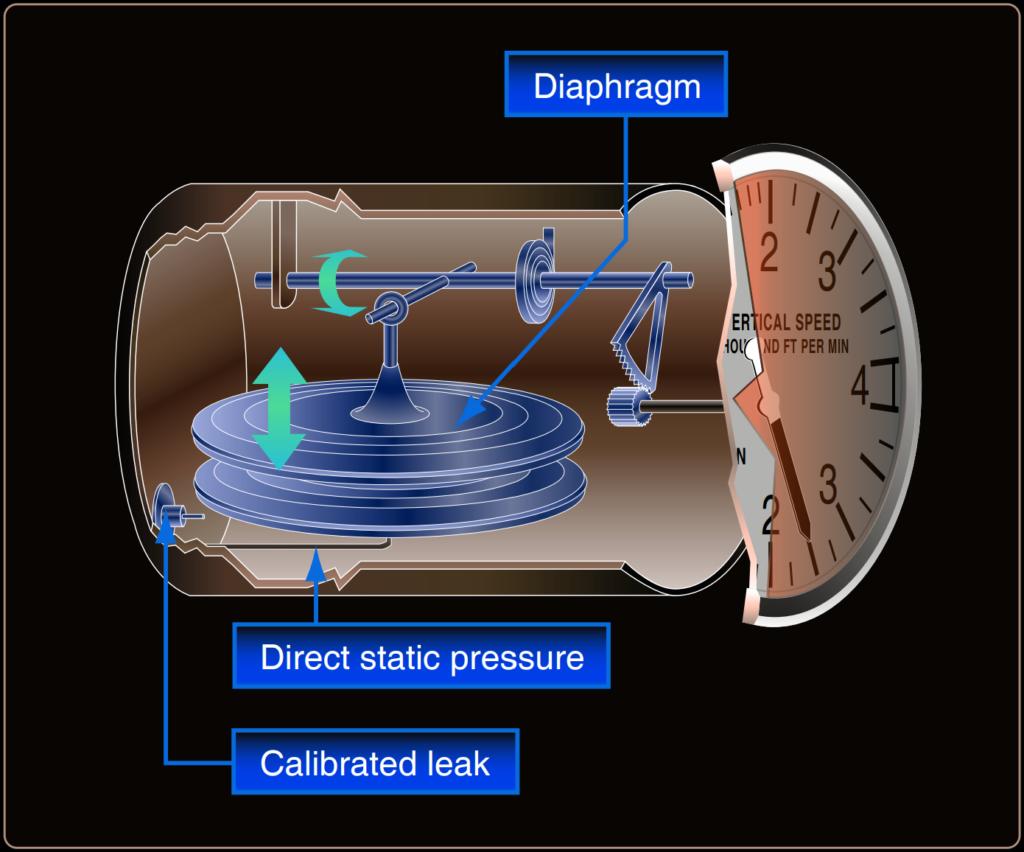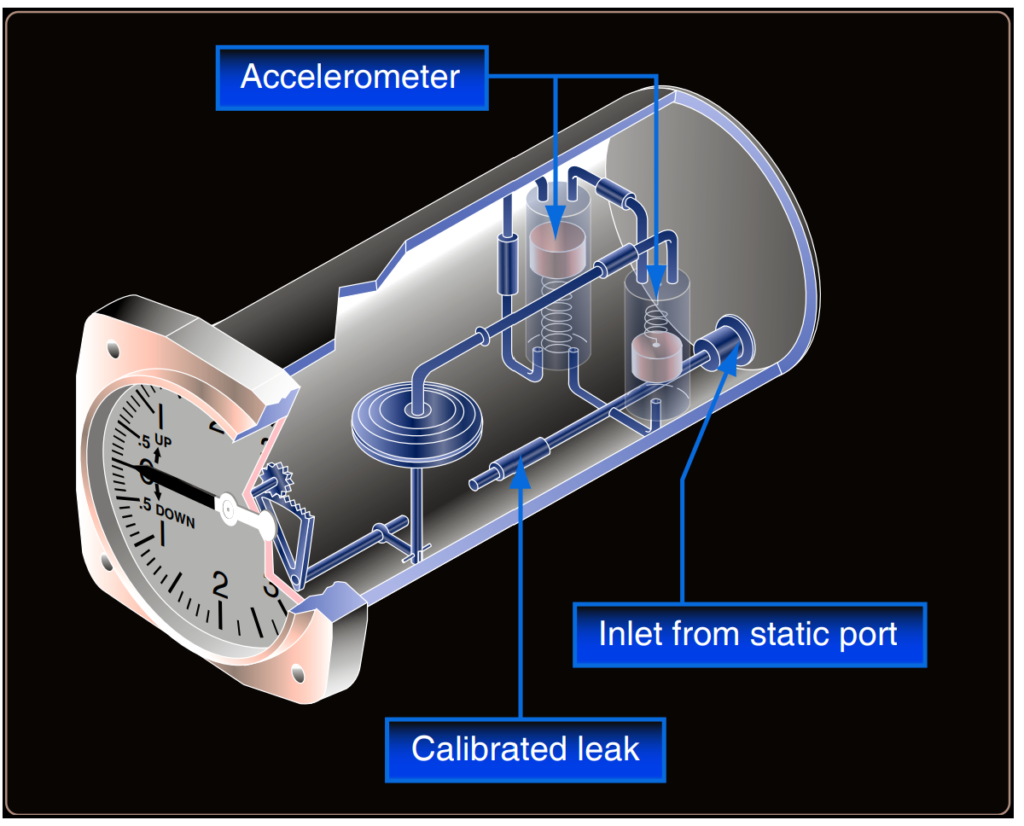The Vertical Speed Indicator (VSI) is an essential instrument used in aviation to provide pilots with real-time information about the rate of ascent or descent of the aircraft. Also known as a variometer or vertical velocity indicator, the VSI is crucial for maintaining safe flight operations, especially during climbs, descents, and approaches to landing.
What is Vertical Speed Indicator (VSI)?
The Vertical Speed Indicator (VSI), also known as the Vertical Velocity Indicator (VVI), is an instrument that shows whether an aircraft is climbing, descending, or maintaining level flight. It provides information about the rate of ascent or descent, measured in feet per minute (fpm). When calibrated correctly, the VSI should display zero when the aircraft is flying level.

VSI Working Principle.
The Vertical Speed Indicator (VSI) operates solely from static pressure but functions as a differential pressure instrument. It consists of a diaphragm with connecting linkage and gearing enclosed within an airtight case. The diaphragm is directly connected to the static line of the pitot-static system, while the area outside the diaphragm, within the instrument case, is connected to the static line through a restricted orifice, also known as a calibrated leak.
Both the diaphragm and the case receive air from the static line at the current atmospheric pressure. However, the diaphragm receives unrestricted air, whereas the case receives static pressure through the calibrated leak. When the aircraft is on the ground or in level flight, the pressures inside the diaphragm and the instrument case are equal, and the VSI pointer indicates zero.
During climbs or descents, the pressure inside the diaphragm changes immediately, but due to the restricted flow through the calibrated leak, the pressure in the case changes more slowly. This results in a pressure differential between the diaphragm and the case, causing the diaphragm to contract or expand accordingly. The pressure differential is then indicated on the instrument needle as a climb or descent rate.
Once the pressure differential stabilizes at a specific ratio, the VSI needle accurately indicates the rate of altitude change.
How many types of information displayed by VSI?
The Vertical Speed Indicator (VSI) provides two types of information:
- Trend Information: This indicates the immediate direction of the aircraft’s climb or descent. For instance, if the aircraft transitions from level flight to a climb, the VSI needle moves upward to show a climb. Similarly, if the aircraft enters a descent, the needle moves downward to indicate descent.
- Rate Information: Once the aircraft stabilizes in a climb or descent, the VSI displays a stabilized rate of change in altitude in feet per minute (fpm). This rate information helps pilots maintain a consistent vertical profile.
The transition from trend information to rate information involves a brief lag period, typically around 6 to 9 seconds. During this lag, the VSI stabilizes to accurately indicate the new rate of climb or descent. However, rough control inputs or turbulence can prolong the lag period, leading to erratic or unstable rate indications.

Some aircraft are equipped with an Instantaneous Vertical Speed Indicator (IVSI), which incorporates accelerometers to compensate for the lag inherent in traditional VSIs. This allows for more immediate and accurate rate indications, particularly in dynamic flight conditions.
How to check Vertical Speed Indicator Instrument?
As part of your preflight check, ensure the Vertical Speed Indicator (VSI) reads close to zero before leaving the ramp area. Check it again just before takeoff. If the VSI shows anything other than zero, you can consider that indication as the zero mark. Typically, if the needle isn’t exactly at zero, it’s only slightly above or below the zero line.
After takeoff, observe the VSI trend upward to indicate a positive rate of climb. Once you’ve established a stabilized climb, you can reference the rate of climb indicated on the VSI. This helps ensure that your aircraft is climbing at the desired rate.
How does a vertical speed indicator work?
During ascent, as the aircraft climbs, the external static pressure decreases. This lower-pressure air flows through the static line into the diaphragm and case of the VSI, resulting in reduced pressure within the diaphragm. Initially, due to a calibrated leak, the case maintains a higher pressure compared to the diaphragm.
This pressure differential causes the flexible diaphragm to collapse inward, akin to an accordion, due to the pressure difference. The movement of the diaphragm activates internal mechanisms within the VSI, such as rods and gears, which ultimately move the needle on the instrument’s face to display the rate of climb.
Conversely, during descent, as the aircraft descends and the external static pressure increases, higher-pressure air enters the diaphragm and case of the VSI. This causes the pressure within the diaphragm to exceed that within the case. Consequently, the flexible diaphragm expands outward, moving the needle on the VSI instrument face in the opposite direction to indicate the rate of descent. By precisely sensing changes in air pressure and translating them into vertical speed indications, the VSI plays a vital role in aiding pilots to maintain safe and controlled flight operations.
How to read vertical speed indicator?
The VSI typically features a vertical scale calibrated in units of vertical speed, such as feet per minute (fpm) or meters per second (mps). The scale is divided into positive and negative values, with positive values indicating climbs and negative values indicating descents. There is usually a zero reference line on the scale.
Read Also: What is Altimeter? Working Principle, Setting the Altimeter, Operation, Types